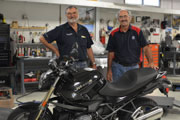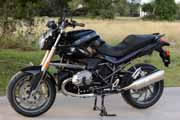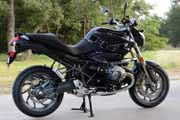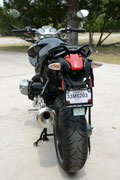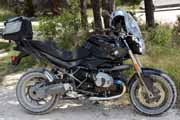| Home | Garage | Motorcycles |
2013 BMW R1200R
My first new motorcycle in 27 years! I went to Lone Star BMW in June 2013 to pick up a $30 electrical relay for the K75, and ended up asking Ed, one of the bike sales staff, for a quote for the 90 Jahre special edition of the BMW R1200R (gold anodized brake calipers and fork tubes, black sapphire metallic paint, and dark gray engine treatment). It turned out that one was on its way to the shop, which was more than I could resist after several years of temptation.
I have compiled some data on fuel mileage and range through 26,952 miles at the bottom of the page.
I'm also now on my second set of tires, replacing the original Bridgestones with Michelins.
Attributes- 1170 cc four-stroke, two-cylinder, air- and oil-cooled engine (see specifications below)
- Purchased new on June 21, 2013 from Lone Star BMW/Triumph Motorcycles, Austin, Texas
- Safety features include ABS, Automatic Stability Control, and Tire Pressure Monitoring System
- BMW-installed items included the onboard computer, the "high" comfort seat, and saddle bag rails
- VIN: WB1049007DZX97497
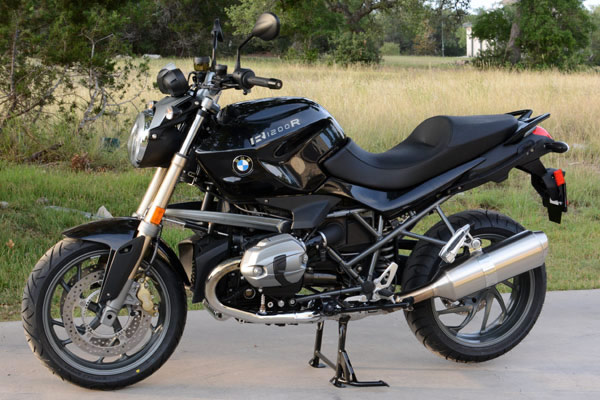 |
| 2013 BMW R1200R, 90 Jahre edition, at home near Driftwood, Texas. This was taken on June 21, 2013, the day it arrived. Yet to be installed are the rear rack and the tall windscreen. |
Engine and Performance (mostly from U.S. Rider's Manual)
| Type | Horizontally opposed, two cylinders, double overhead cam, four valves per cylinder |
| Cooling | Air and oil |
| Fuel delivery | Electronic fuel injection |
| Displacement | 1170 cc |
| Cylinders | 2 |
| Bore & Stroke | 101 x 73 mm |
| Compression ratio | 12.0:1 |
| Maximum RPM | 8500 |
| RPM at idle | 1150 |
| Power | 110 hp (81 kW) at 7750 rpm |
| Torque | 88 ft-lb (119 N-m) at 6000 rpm |
| Top Speed | >124 mi/hr (200 km/hr) |
| Fuel Consumption | 4.1 liters per 100 km at 90 km/hr; 5.5 liters per 100 km at 120 km/hr |
Transmission, Tires, and Brakes
| Clutch | Single plate, dry |
| Primary gear ratio | 1.737 |
| Gearbox | 1st: 2.375; 2nd: 1.696; 3rd: 1.296; 4th: 1.065; 5th: 0.939; 6th: 0.848 |
| Drive Mechanism | Shaft |
| Final Drive | 2.75:1 |
| Front Suspension | BMW Telelever, central spring strut with coil pressure spring, 120 mm (4.7 in) travel |
| Rear Suspension | BMW Paralever, single arm, single-tube, gas-filled shock absorber, 140 mm (5.5 in) travel |
| Front Wheel | Cast aluminum, MT H2, 3.50 in. x 17 in. |
| Front Tire Size and Inflation | 120 / 70 ZR 17, 2.5 bar, 36.3 psi cold inflation pressure |
| Front Tire (original) | Bridgestone Battlax BT021F Sport Touring; 120/70 ZR17 M/C (58W) |
| Rear Wheel | Cast aluminum, MT H2, 5.50 in. x 17 in. |
| Rear Tire Size and Inflation | 180 / 55 ZR 17, 2.9 bar, 42.1 psi cold inflation pressure |
| Rear Tire (original) | Bridgestone Battlax BT021R Sport Touring; 180/55 ZR17 M/C (73W) |
| Front Brakes | 2 disks, hydraulically operated, 320 mm (12.6 in.) diameter |
| Rear Brakes | Single disk, 265 mm (10.4 in.) diameter |
Dimensions and Capacities
| Length | 2145 mm (84.4 in) |
| Width (with mirrors) | 906 mm (35.7 in.) |
| Height (with mirrors) | 1317 mm (51.9 in.) |
| Seat Height | 830 mm (32.7 in.), with high comfort seat |
| Wheelbase (Unladen) | 1495 mm (58.9 in.), from BMW website |
| Ground Clearance (Unladen) | ? |
| Weight (Dry) | 198 kg (437 lb), from BMW website |
| Weight (Curb) | 227 kg (500 lb) |
| Gross Weight Limit | 450 kg (992 lb) |
| Fuel Tank Capacity | 18 L (4.8 gal), including 3 L (0.8 gal) reserve |
| Engine oil capacity | 4.0 L (1.1 gal), SAE 15W-50, API SJ/JASO MA2 |
| Gearbox oil capacity | ? |
| Final drive capacity | 180 cubic cm (6 U.S. fluid ounces) [Internet rumor; not verified] |
Parts
| Spark plugs (4; two per cylinder) | NGK MAR8B-JDS |
| Headlight, low beam and high beam (separate bulbs) | H11 / 12 V / 55 W |
| Bulb, parking light | W5W / 12 V / 5 W |
| Taillight/brake light | P21 / 5 W / 12 V / 5 W / 21 W |
| Turn indicator light, front flashing | RY10W / 12 V / 10 W |
| Turn indicator light, rear flashing | RY10W / 12 V / 10 W |
Photo Gallery
As of April 2021, I have more than 26,000 miles on this motorcycle. I have kept notes on every gas station visit so far, and have a pretty good idea of fuel mileage and tank range. Most of my riding has been between home and work on a 28-mile, one-way highway commute. So far, I have consumed 564.4 U.S. gallons of premium unleaded gasoline while riding 26,952 miles, which works out to 47.5 miles per US gallon (4.96 liters per 100 km). The fuel cost averages about 6.6 cents per mile. The average mileage indicated on the computer is a little optimistic, generally indicating somewhere between 49 and 52 miles per gallon for each full tank.
The most fuel I have been able to add to the tank is 5.38 gallons, a fair bit more than the specified capacity of 4.8 gallons. I do let the fuel go higher up the plastic filler tube than is recommended in the manual, but only when I know I'll be consuming some of the fuel before parking the motorcycle. I haven't yet run the motorcycle out of fuel. The farthest I've ridden on a tank of fuel is 257 miles. On that tan, the computer indicated I had 18 miles left before empty. I generally travel more than 200 miles before refilling the tank.
If I estimate the remaining fuel by dividing the indicated "miles to empty" by the average fuel mileage and add that volume to the amount I put into the tank, I can estimate the total usable volume of the tank (assuming the bike actually runs out of fuel when the "miles to empty" goes to 0). Using that approach, the estimated usable capacity averages 5.61 US gallons (20.6 liters).
My 2013 R1200R came with Bridgestone Battlax BT021 sport-touring tires. Given that I'm not an overly aggressive rider, I didn't need to replace them until I reached 10,427 miles. Even then, both tires had miles remaining before the wear indicators would have been level with the tread. A center ridge had formed on the front tire, and there was some flattening along the centerline of the rear tire (thanks to a lot of commuting on a high-speed highway). A screw in the center of the front tire hastened the tire switch. I replaced the original Bridgestones with a set of Michelin Pilot Road 4 tires, which allegedly will give longer life and better traction on wet streets. We'll see! Surprisingly (to me, anyway), the tire costs per mile ridden (a little over 5 cents per mile) aren't much less than the fuel cost per mile (7 cents per mile)!
